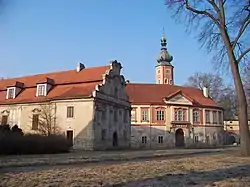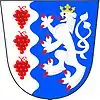Liběchov
Liběchov (Czech pronunciation: [ˈlɪbjɛxof]; German: Liboch) is a town in Mělník District in the Central Bohemian Region of the Czech Republic. It has about 1,100 inhabitants.
Liběchov | |
|---|---|
 Liběchov Castle | |
 Flag  Coat of arms | |
 Liběchov Location in the Czech Republic | |
| Coordinates: 50°24′29″N 14°26′48″E | |
| Country | |
| Region | Central Bohemian |
| District | Mělník |
| First mentioned | 1311 |
| Government | |
| • Mayor | Vladimíra Zralíková |
| Area | |
| • Total | 11.78 km2 (4.55 sq mi) |
| Elevation | 171 m (561 ft) |
| Population (2023-01-01)[1] | |
| • Total | 1,093 |
| • Density | 93/km2 (240/sq mi) |
| Time zone | UTC+1 (CET) |
| • Summer (DST) | UTC+2 (CEST) |
| Postal code | 277 21 |
| Website | www |
Administrative parts
The village of Ješovice is an administrative part of Liběchov.
Etymology
The name is derived from the personal name Luběch or Liběch, meaning "Luběch's/Liběch's (court)".[2]
Geography
Liběchov is located about 3 kilometres (2 mi) north of Mělník and 32 km (20 mi) north of Prague. It lies on the border between the Ralsko Uplands and Jizera Table. The municipality is situtated on the right bank of the Elbe River, at its confluence with the Liběchovka Stream.
History
The first written mention of Liběchov is from 1311. In the early 15th century, it was owned by a branch of the lords of Dubá. From 1440, it was property of a family that called itself the lords of Liběchov. In the second half of the 16th century, Liběchov was acquired by Knight Kašpar Belvic of Nostvice. He har rebuilt the local fortress into a Renaissance residence. The settlement was depopulated as a result of the Thirty Years' War and then Germanized. Among the most notable owners of Liběchov were the noble families of Pachta (18th century) and Veith (19th century).[2]
Before World War II, half of the population were ethnic Germans and half were Czechs. As a result of the Munich Agreement, the municipality was annexed by Nazi Germany and was administered as part of the Reichsgau Sudetenland. After the war, Germans were expelled and Liběchov was resettled by Czechs.[2]
Demographics
|
|
| ||||||||||||||||||||||||||||||||||||||||||||||||||||||
| Source: Censuses[3][4] | ||||||||||||||||||||||||||||||||||||||||||||||||||||||||
Sights
The main landmark is the Liběchov Castle. It was originally a water fortress from ther 14th century, rebuilt into a Renaissance castle in the 16th century. In 1720–1730, the castle was baroque rebuilt by the architect František Maxmilián Kaňka and extended. After the fire in 1811, Neoclassical modifications were made. The castle was damaged during the 2002 European floods and has been inaccessible since then, but is surrounded by a freely accessible castle park.[2][5]
The Church of Saint Gall was built in the Baroque style in 1738–1741.[6]
North of the town is Klácelka, an artificial cave featuring large sculptures by Václav Levý.
Notable people
- Antonín Veith (1793–1853), patron of the arts; lived and died here
References
- "Population of Municipalities – 1 January 2023". Czech Statistical Office. 2023-05-23.
- "Z historie Liběchova" (in Czech). Město Liběchov. Retrieved 2023-02-02.
- "Historický lexikon obcí České republiky 1869–2011 – Okres Mělník" (in Czech). Czech Statistical Office. 2015-12-21. pp. 5–6.
- "Population Census 2021: Population by sex". Public Database. Czech Statistical Office. 2021-03-27.
- "Zámek Liběchov" (in Czech). CzechTourism. Retrieved 2023-02-02.
- "Kostel sv. Havla" (in Czech). National Heritage Institute. Retrieved 2023-02-02.